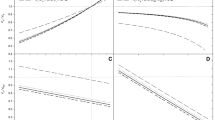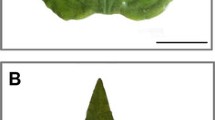Abstract
On-line instantaneous carbon isotope discrimination was measured in conjunction with net uptake of CO2 in leaves of exposed and shaded plants of the C3-CAM intermediate Clusia minor growing under natural conditions in Trinidad. At the end of the rainy season (late January-early February, 1992) C3 photosynthesis predominated although exposed leaves recaptured a small proportion of respiratory CO2 at night for the synthesis of malic acid. Citric acid was the major organic acid accumulated by exposed leaves at this time with a citric: malic acid ratio of 11:1. Values of instantaneous discrimination (Δ) in exposed leaves during the wet season rose from 17.1‰ shortly after dawn to 22.7‰ around mid-day just before stomata closed, suggesting that most CO2 was fixed by Rubisco at this time. During the late afternoon, instantaneous Δ declined from 22.2‰ to 17‰, probably reflecting the limited contribution from PEPc activity and an increase in diffusional resistance to CO2 in exposed leaves. Shaded leaves showed no CAM activity and CO2 uptake proceeded throughout the day in the wet season. The decrease in instantaneous Δ from 27‰ in the morning to 19.2‰ in the late afternoon was therefore entirely due to diffusional limitation. Leaves sampled in the dry season (mid-March, 1992) had by now induced full CAM activity with both malic and citric acids accumulated overnight and stomata closed for 4–5 h over the middle of the day. Values of instantaneous Δ measured over the first 3 h after dawn (6.4–9.1‰) indicated that C4 carboxylation dominated CO2 uptake for most of the morning when rates of photosynthesis were maximal, implying that under natural conditions, the down regulation of PEPc in phase II occurs much more slowly than laboratory-based studies have suggested. The contribution from C3 carboxylation to CO2 uptake during phase II was most marked in leaves which accumulated lower quantities of organic acids overnight. In exposed leaves, measurements of instantaneous Δ during the late afternoon illustrated the transition from C3 to C4 carboxylation with stomata remaining open during the transition from dusk into the dark period. Uptake of CO2 by shaded leaves during the late afternoon however appeared to be predominantly limited by decreased stomatal conductance. The short-term measurements of instantaneous Δ were subsequently integrated over 24 h in order to predict the leaf carbon isotope ratios (δp) and to compare this with the δp measured for leaf organic material. Whilst there was close agreement between predicted and measured δp for plants sampled in the wet season, during the dry season the predicted carbon isotope ratios were 5–9‰ higher than the measured isotope ratios. During the annual cycle of leaf growth most carbon was fixed via the C3 pathway although CAM clearly plays an important role in maintaining photochemical integrity in the dry season.
Similar content being viewed by others
References
Ball E, Hann J, Kluge M, Lee HSJ, Lüttge U, Orthen B, Popp M, Schmitt AK, Ting IP (1991a) Ecophysiological comportment of the tropical CAM-tree Clusia in the field. I. Growth of Clusia rosea Jacq. on St. John, US Virgin Islands, Lesser Antilles. New Phytol 117: 473–481
Ball E, Hann J, Kluge M, Lee HSJ, Lüttge U, Orthen B, Popp M, Schmitt AK, Ting IP (1991b) Ecophysiological comportment of the tropical CAM-tree Clusia in the field. II. Modes of photosynthesis in trees and seedlings. New Phytol 117: 483–491
Bender MM, Rouhani I, Vines HM, Black CC (1973) 13C/12C ratio changes in crassulacean acid metabolism plants. Plant Physiol 52: 427–430
Borland AM, Griffiths H (1990) The regulation of CAM and respiratory recycling by water supply and light regime in the C3-CAM intermediate Sedum telephium L. Funct Ecol 4: 33–39
Borland AM, Griffiths H (1992) Properties of phosphoenolpyruvate carboxylase and carbohydrate accumulation in the C3-CAM intermediate Sedum telephium L. grown under different light and watering regimes. J Exp Bot 43: 353–361
Borland AM, Griffiths H, Maxwell C, Broadmeadow MSJ, Griffiths NM, Barnes JD (1992) On the ecophysiology of the Clusiaceae in Trinidad: expression of CAM in Clusia minor during the transition from wet to dry season and characterisation of three endemic species. New Phytol 122: 349–357
Broadmeadow MSJ, Griffiths H, Maxwell C, Borland AM (1992) The carbon isotope ratio of plant organic material reflects temporal and spatial variations in CO2 partial pressure and δ13C within tropical forest formations in Trinidad. Oecologia 89: 435–441
Deleens E, Queiroz O (1984) CAM and carbon isotope composition: origin of the constitutive carbon in young leaves of Bryophyllum daigremontianum Berger. Plant Cell Environ 7: 23–27
Demmig-Adams B, Adams W.W. III, Winter K, Meyer A, Schreiber U, Pereira JS, Krüger A, Czygan F-Z, Lange O (1989) Photochemical efficiency of photosystem II, photon yield of O2 evolution, photosynthetic capacity and carotenoid composition during the midday depression of net CO2 uptake in Arbutus unedo growing in Portugal. Planta 177: 377–387
Evans JR, Sharkey TD, Berry SA, Farquhar GD (1986) Carbon isotope discrimination measured concurrently with gas exchange to investigate CO2 diffusion in leaves of higher plants. Aust J Plant Physiol 13: 281–292
Farquhar GD, Ehleringer JR, Hubick KT (1989) Carbon isotope discrimination and photosynthesis. Annu Rev Plant Physiol 40: 503–537
Franco AC, Ball E, Lüttge U (1990) Patterns of gas exchange and organic acid oscillations in tropical trees of the genus Clusia. Oecolgia 85: 108–114
Franco AC, Ball E, Lüttge U (1991) The influence of nitrogen, light and water stress on CO2 exchange and organic acid accumulation in the tropical C3-CAM tree Clusia minor. J Exp Bot 42: 597–603
Franco AC, Ball E, Lüttge U (1992) Differential effects of drought and light levels on accumulation of citric and malic acids during CAM in Clusia. Plant Cell Environ 15: 390–829
Griffiths H (1992) Carbon isotope discrimination and the integration of carbon assimilation pathways in terrestrial CAM plants. Plant Cell Environ 15: 1051–1062
Griffiths H, Broadmeadow MSJ, Borland AM, Hetherington CS (1990) Short-term changes in carbon-isotope discrimination identify transitions between C3 and C4 carboxylation during crassulacean acid metabolism. Planta 181: 604–610
Haag-Kerwer A, Franco AC, Lüttge U (1992) The effect of temperature and light on the gas exchange and acid accumulation in the C3-CAM plant Clusia minor L. J Exp Bot 43: 345–352
Hohorst HJ (1965) L-(-)-malate. Determination with malic acid dehydrogenase and DPN. In: Bergmeyer HU (ed) Methods of enzymatic analysis. Academic Press, New York, pp 328–332
Kalt W, Osmond CB, Siedow JN (1990) Malate metabolism in the dark after 13CO2 fixation in the crassulacean acid metabolism plant Kalanchoë tubiflora. Plant Physiol 94: 826–832
Kluge M, Böhlke CH, Queiroz O (1981) Crassulacean acid metabolism (CAM) in Kalanchoë: Changes in intercellular CO2 concentration during a normal CAM cycle and during cycles in continuous light or darkness. Planta 152: 87–92
Lüttge U (1988) Day-night changes of citric acid levels in CAM: phenomenon and ecophysiological significance. Plant Cell Environ 11: 445–451
Lüttge U, Stimmel K-H, Smith JAC, Griffiths H (1986) Comparitive ecophysiology of CAM and C2 bromeliads. II. Field measurements of gas exchange of CAM bromeliads in the humid tropics. Plant Cell Environ 9: 377–383
Möllering H (1985) Citrate. Determination with citrate lyase, MDH and LDH. In: Bergmeyer HU (ed) Methods of enzymic analysis, 3rd edn, vol VII. Academic Press, New York pp 2–12
Nimmo GA, Wilkins MB, Fewson CA, Nimmo HG (1987) Persistent circadian rhythms in the phosphorylation state of phosphoenolpyruvate carboxylase from Bryophyllum feldtschenkoi leaves and its sensitivity to inhibition by malate. Planta 170: 408–415
Osmond CB (1979) Crassulacean acid metabolism: a curiosity in context. Ann Rev Plant Physiol 29: 379–414
Osmond CB, Allaway WG (1974) Pathways of CO2 fixation in the CAM plant Kalanchoë daigremontiana. I. Patterns of 14CO2 fixation in the light. Aust J Plant Physiol 1: 503–511
Popp M, Kramer D, Lee H, Diaz M, Ziegler H, Lüttge U (1988) Crassulacean acid metabolism in tropical dicotyledenous trees of the genus Clusia. Trees 1: 238–247
Schmitt AK, Lee HSJ, Lüttge U (1988) The response of the C3-CAM tree, Clusia rosea, to light and water stress. I. Gas exchange characteristics. J Exp Bot 39: 1581–1590
Smith JAC, Griffiths H, Lüttge U, Crook CE, Griffiths NM, Stimmel K-H (1986) Plant Cell Environ 9: 395–410
Tenhunen JD, Catarino FM, Jange OL, Oechel WC (1987) Plant response to stress. Functional analysis in mediterranean ecosystems. Springer, Berlin Heidelberg New York
Ting IP, Lord EM, Sternberg L, da SL, DeNiro MJ (1985) Crassulacean acid metabolism in the strangler Clusia rosea Jacq. Science 229: 969–971
Tinoco Ojanguren C, Vazquez-Yanes C (1983) Especies CAM in la selva humeda tropical de los Tuxtlas, Veracruz. Bol Soc Bot Mexico 45: 150–153
Winter K (1982) Properties of phosphoenolpyruvate carboxylase in rapidly prepared, desalted leaf extracts of the Crassulacean acid metabolism plant Mesembryanthemum crystallinum L. Planta 154: 298–308
Author information
Authors and Affiliations
Rights and permissions
About this article
Cite this article
Borland, A.M., Griffiths, H., Broadmeadow, M.S.J. et al. Short-term changes in carbon-isotope discrimination in the C3-CAM intermediate Clusia minor L. growing in Trinidad. Oecologia 95, 444–453 (1993). https://doi.org/10.1007/BF00321001
Received:
Accepted:
Issue Date:
DOI: https://doi.org/10.1007/BF00321001




